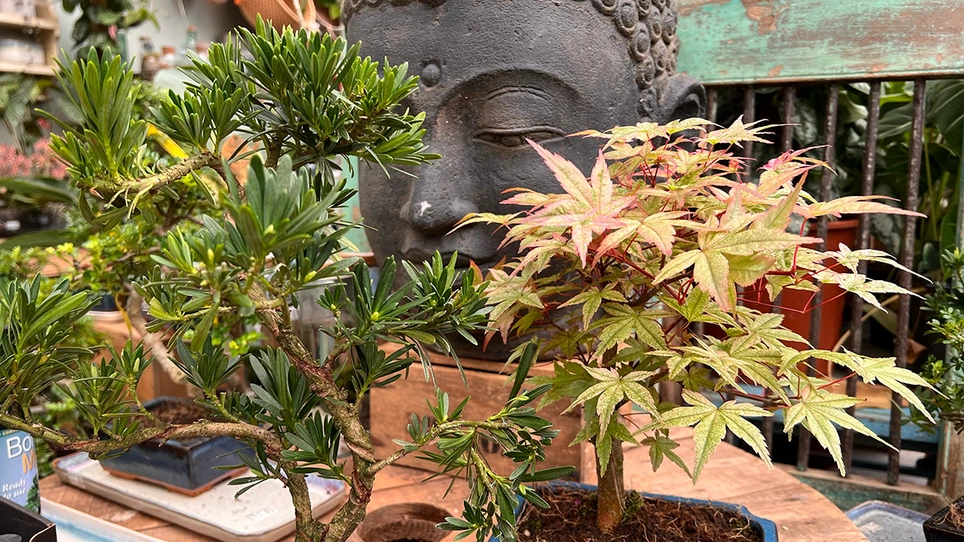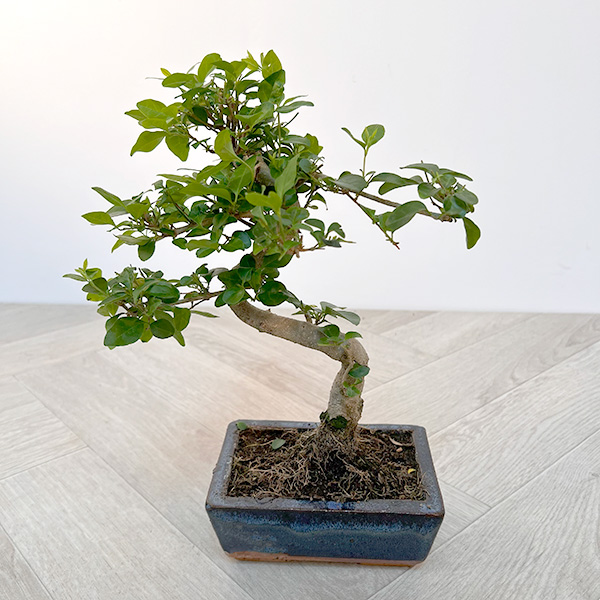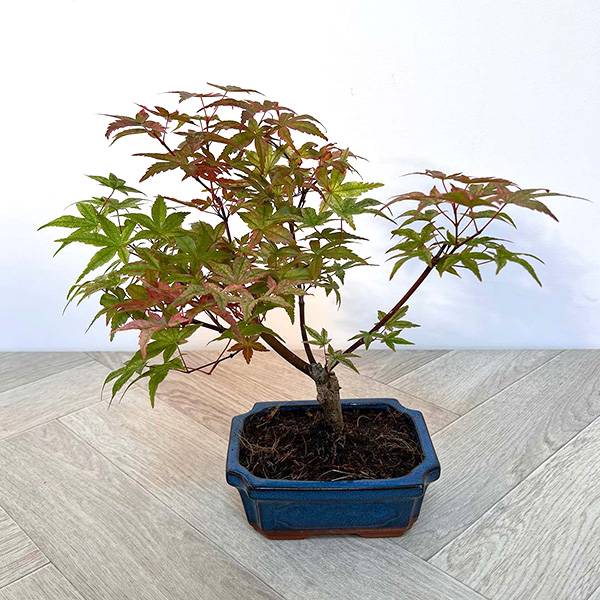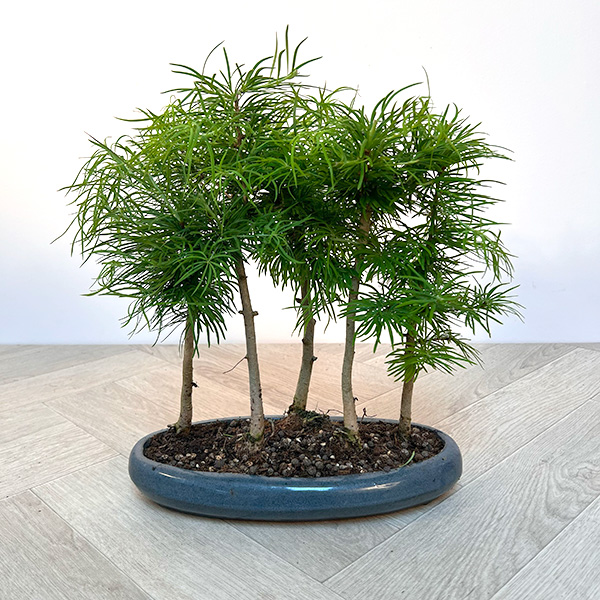
Bonsai, which literally translates to "planted in a container", is more than just a hobby; it's a dynamic art form that reflects the Japanese philosophy of balance, harmony, and respect for nature. Bonsai gardening is about creating a living sculpture, a miniaturised but realistic representation of nature's grandeur.
In the heart of Kentish Town, London, lies the Boma Garden Centre, an oasis boasting an exquisite collection of Bonsai trees, all the essential tools, and the expertise to help you embark on this fulfilling journey.
For the novice Bonsai enthusiast, Boma offers an array of resources. From Bonsai potting mix, snips, and Bonsai focus feed to traditional terracotta pots in rectangular and oval shapes, both with and without saucers, everything you need to nurture your Bonsai at home is right at your fingertips.
To start, let's explore some of the Bonsai species Boma stocks, each with its own unique appeal:
 |
• Ligustrum, or the Mandarin Tree, thrives in the British climate. Its dark, glossy leaves form a striking contrast against its light bark, a vivid embodiment of the spirit of Bonsai.
• Zelkova serrata, the Chinese Elm, is renowned for its resilient nature and is versatile for both indoor and outdoor care, although protection from frost is crucial.
• The Syzgium buxifolium or Chinese Myrtle, is a subtropical evergreen with petite, dense foliage, adding an elegant texture to any space. It also requires protection from frost.
• The Ginkgo biloba, or Maidenhair Tree, is an outdoor species. It's a living fossil, with a lineage dating back millions of years, and its fan-shaped leaves turn a brilliant yellow in autumn.
• The Ilex crenata, or Japanese Holly, is an easy-to-care-for variety suitable for indoor or outdoor cultivation.
 |
• Acer Palmatum 'Deshojo' Japanese Maple is best kept outdoors. Its breathtaking red foliage is a vibrant display in spring, later turning green, and finally, a fiery crimson in autumn.
• The Podocarpus macrophylla, or Buddhist Pine, is a slow-growing, hardy Bonsai that can adapt to both indoor and outdoor environments.
• Zanthoxylum pipertum, or the Japanese Pepper Tree, is suitable for indoor or outdoor cultivation and is known for its aromatic properties.
• The Ficus microcarpa, commonly known as Ficus Ginseng, is an excellent choice for beginners and can tolerate indoor conditions well.
 |
• Metasequoia glyptostroboides, also known as the Dawn Redwood, is a deciduous outdoor Bonsai that exhibits an awe-inspiring symphony of colours. In the spring and summer, its needle-like leaves are lush and green, transitioning into coppery-red hues in autumn before shedding its foliage in winter, revealing its stunning reddish-brown bark.
• Pseudolarix amabilis, or the Golden Larch, is an enchanting outdoor Bonsai known for its seasonal display. Its soft, feathery foliage starts as a bright emerald green, gradually transforming into a brilliant gold in autumn, lending to its name. This tree offers a unique addition to any Bonsai collection with its picturesque transformation.
Boma also stocks the Chladophora Aegagropila, or Marimo. This decorative moss ball, steeped in Japanese folklore, is said to bring good luck.
Caring for a Bonsai requires patience and understanding. Start by positioning your tree in a bright spot, away from direct sunlight or draughts. Remember to water your Bonsai when the topsoil feels slightly dry, and use the Bonsai focus feed to ensure your tree gets all the nutrients it needs. Regular pruning will help maintain your tree’s shape and promote the growth of smaller, proportionate leaves.
Regardless of the species you choose, Bonsai's true beauty lies in the patience and dedication invested in its cultivation. The practice is a calming, meditative process, an opportunity to connect with nature on a miniature scale.
How to Care for Bonsai Trees
1. Watering: This is perhaps the most critical aspect of Bonsai care. As each tree is unique, there are no hard and fast rules about when to water. However, a good rule of thumb is to water your Bonsai when the topsoil feels slightly dry to the touch. Overwatering or underwatering can harm the tree, so observe its needs and respond accordingly.
2. Feeding: Bonsai trees need nutrients to thrive. They are usually potted in nutrient-poor soil, so regular feeding is important. Use a specialist Bonsai fertiliser such as Bonsai Focus feed, which is specially formulated to provide a well-balanced nutrient solution ideal for healthy growth and flowering.
3. Pruning: To maintain your tree’s miniature stature and shape, you need to prune regularly. Use Bonsai snips for this delicate task. Bonsai is an art, and pruning is your way of creating your masterpiece. Remember, patience is key.
4. Positioning: Positioning your Bonsai is key to its survival. Outdoor Bonsai should be placed in a spot with plenty of sunlight but out of direct midday sun. Indoor Bonsai need a bright spot away from draughts or radiators.
5. Repotting: Bonsai trees need repotting every two to five years. You can tell it’s time if your tree's growth has slowed or if the roots have taken the shape of a pot. Boma carries Bonsai Focus repotting mix, which can be used with Boma’s traditional terracotta pots are perfect for this.
6. Overwintering: Some Bonsai trees, especially the outdoor varieties, need protection from frost. You can wrap the pot and the soil in insulating material but remember, the tree still needs light and water.
7. Misting: Use Bonsai Myst to increase humidity by misting the base and the stem during the growing season (March to September) once every 7-10 days. Bonsai must contain essential nutrients, including seaweed.
8. Training: Wiring and reshaping your Bonsai help achieve the desired shape. This should be done with care and preferably under expert guidance until you learn the ropes.
If you're a beginner, start with a hardy and forgiving species, such as the Ficus Ginseng or the Japanese Holly. Boma has these and more, and you can always seek advice from our horticultural Bonsai specialists.
The art of Bonsai is not just about creating a beautiful miniature tree; it's also about the journey of nurturing and understanding the essence of nature. It's a wonderful opportunity to practise mindfulness and to cultivate patience and focus.
Remember, every Bonsai is unique, reflecting the time, care, and passion invested by the gardener. So why not pay a visit to the Boma Garden Centre's Bonsai Garden and choose a Bonsai that speaks to you? Start your own Bonsai journey today, with the Boma team there to guide and support you every step of the way. Your tranquil oasis awaits.







